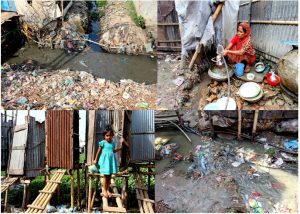46
Mahin Al Nahian, International Centre for Diarrhoeal Disease Research, Bangladesh
Dhaka, the capital of Bangladesh, is an example of one of the most rapidly unplanned urbanizing cities in world; as could be leveled as a ‘Sick City.’ The history of Dhaka dated back from the 7th century CE, when it was ruled by Hindu Kingdoms, Mughals, British and Pakistan before being liberated in 1971 [Wikipedia]. With an estimated population of more than 15 million people, it is the largest city in Bangladesh and the 8th largest city in the world. It is also one of the world’s most densely populated cities [Haque, Tsutsumi, & Capon, 2014].
The situation of Dhaka city is still most precisely described by UN-Habitat as:
“take one of the most unplanned urban centers in the world, wedge it between four flood-prone rivers in the most densely packed nation in Asia, then squeeze it between the Himalaya mountain range and a body of water that not only generates violent cyclones and the occasional tsunami, but also creeps further inland every year, washing away farmland, tainting drinking water, submerging fertile deltas, and displacing villagers as it approaches – and there you have it: Dhaka.” [United Nations Human Settlements Programme (UN-HABITAT), 2008/09]
When an added layer of climate change impacts are considered, we see a ghost city comprising of a seriously ill population. With one third of the city dwellers living in slums and squatter settlements with no to limited service provisions; the status of existing water supply and sanitation need to be critically analyzed for setting priorities in the public health domain in order to help people survive and sustain life.
This article is based on secondary literature thus it tries to assess existing scenarios, future challenges and options of development in relation to the water supply and sanitation sectors.
Dhaka Water Supply and Sewerage Authority (DWASA) is an autonomous public sector organization, entrusted with the responsibility to manage water supply, sewerage disposal (wastewater), and storm water drainage services for Dhaka city. DWASA covers 360 sq. km service area with 12.5 million people (2013) comprising slum, non-slum and other-urban/peri-urban areas of the capital city. The daily water demand in Dhaka city is 2.25 million cubic meters per day, whereas DWASA has the capacity to supply only 2.11 million cubic meters per day; however the Govt. information is questionable because, the quality of water is of primary concern and in dry months of March to May many areas suffer from water scarcity. About 87% of the supplied water comes from ground water abstraction and the remaining 13% comes from surface water treatments. Interestingly, only around 4000 staff in DWASA provide services to the whole population of Dhaka city of which about 88% involved in water supply system and the rest in sewerage disposal. DWASA provides water at the cheapest rate in the world, 0.08 dollars per 1000 litres and is only able to collect revenue that covers only 25% of the operating costs (2010) [Khan, 2013]. Though water coverage is almost 100% of different slum, non-slum and other-urban areas of the city, about 65% of large households (comprising 10+ single units household) share a common water source. About 80% of households have access to pit/flush latrine but about 43% of large households share a common latrine in slum areas [ICDDR, B, 2013].
In a practical sense, the situation is getting worse, as many of the latrines directly dispose the waste in adjacent open water bodies, such as lakes and canals. Sewage is carried through open drains and most alarmingly, many of the water carrying pipes run along these open drains in slum areas.

Contrary to normal population density, in a slum population density is 205,000 person per square kilometer, with the slums being more or less comprised of one storied corrugated iron sheet houses. This complex picture I am sure is shocking to some. Alarmingly, most slum dwellers not only live in substandard and unsanitary conditions but pay more for the cost of basic services like water, gas and electricity. As depicted in the picture, the existing water supply system in most of the slums is totally unhygienic and mostly dominated by local political leaders and hooligans. Slums are illegal entity, so there is no straight forward Govt. policy and process to facilitate the basic services and through these gaps, local political leaders and hooligans run the service provisioning business and collect a price several times higher than DWASA price. Same is valid for gas and electricity services as well (UNICEF, 2010 and Titumir, Hossain, 2004). All these are illegal business, and when authority stops the facilities abruptly for a few days, it is the slum dwellers who suffer most in the crisis. Pollution is pretty common in the water lines and hence incidence of water borne diseases is high in urban slums. Another recent study states that in low income urban areas of Dhaka city, only 14% of household members wash their hands with soap after defecation, identifying barriers such as lack of running water facilities and the relative high cost of soap to household income [ICDDR, B, 2014].
In slum areas some water supply and sanitation projects are run by local NGOs but the justified involvement of DWASA is still far away from accomplishment. Slum eviction is another barrier to sustainable development of such facilities. Overall the environmental situation, increased pollution, air congestion are adding another layer of complexities to the overall water supply and sanitation system issues of low income areas. Dhaka has a poor and out-of-date drainage system and moderate rainfall creates sudden water logging in low elevation slum areas. Hence predicted future climate change scenario with high intensity rainfall in short interval and increased flood risk hazard only provide even worse situation for urban water supply and sanitation of Dhaka city. If all are compared against the population increasing trend, where 21 million are predicted to live within an area of 1,000 Sq. km in Dhaka city by 2025; we only see a city been waiting to be meet its doom by the pressure of its own population induced calamity.
Bangladesh is known as a nation always fighting against natural calamity and thus we can say all hope is yet not lost. Decentralization of city hubs, improved water supply and sanitation system establishing public-private ownership, justified participation of all level stakeholders, good governance and policy implementation are few of the possibilities to fight the existing and future challenges to bring and ensure healthy environment for the residents of Dhaka city.
References
- History of Dhaka – http://en.wikipedia.org/wiki/History_of_Dhaka
- Haque, S.E., Tsutsumi, A., & Capon, A. (2014) Sick Cities: A Scenario for Dhaka City – http://iigh.unu.edu/publications/articles/sick-cities-a-scenario-for-dhaka-city.html
- United Nations Human Settlements Programme (UN-HABITAT) (2008/09). Case Study: Dhaka’s extreme vulnerability to climate change – http://www.preventionweb.net/files/4292_Dhaka20extreme1.pdf
- Khan, T.A. (2013). Dhaka Water Supply and Sewerage Authority: Performance and Challenges. Web report.
- ICDDR, B (2013). Urban Health in Bangladesh: Preliminary Findings from the 2013 Urban Health Survey. Preliminary dissemination handout.
- ICDDR, B (2014). World Water Week: Highlights of icddr,b research on water. Online media bulletin.
- UNICEF (2010). Understanding Urban Inequalities in Bangladesh: A prerequisite for achieving Vision 2021. A study based on the results of the 2009 Multiple Indicator Cluster Survey. UNICEF, Bangladesh. Page 18.
- Titumir. R A M. and Hossain. J., (2004). Barriers to Access to Public Services for the Urban poor: An Enquiry into Dhaka Slums. Journal of the Institute of Bangladesh Studies, Vol. XXVII, 2004.
Acknowledgement
The writer thanks Dushtha Shasthya Kendra (DSK) for their kind approval to using the photos. The photos were taken from Mollar slum and Rosider tek slum of Dhaka city.
Author Biography
Mahin Al Nahian is presently working as Senior Research Officer at Center for Population, Urbanization and Climate Change (CPUCC) in ICDDR, B. He had completed his B.Sc. in Civil and Environmental Engineering from SUST and M.Sc. in Water Resources Development from IWFM, BUET. Mahin worked in WatSan sector both in urban and rural areas and continuing research on climate change and health related issues in South-West Coastal Bangladesh. At present he is involved with Salinity-Hypertension and ESPA delta studies and Arsenic screening survey. Mahin have presented his research findings in several international conferences and some journal articles are in pipeline. His research interests are focused to the social and health aspects of climate change including gender and water resources management. Mahin believes in the intrinsic value of life.
Contact email: mahin.nahian@icddrb.org

